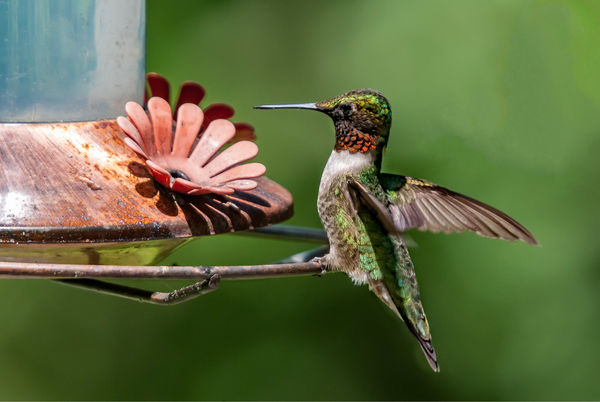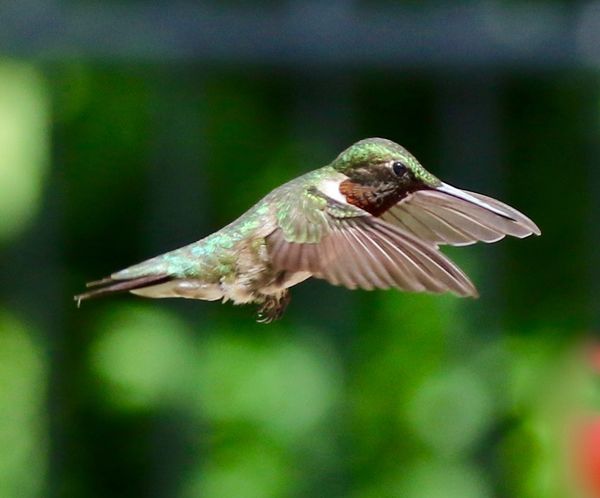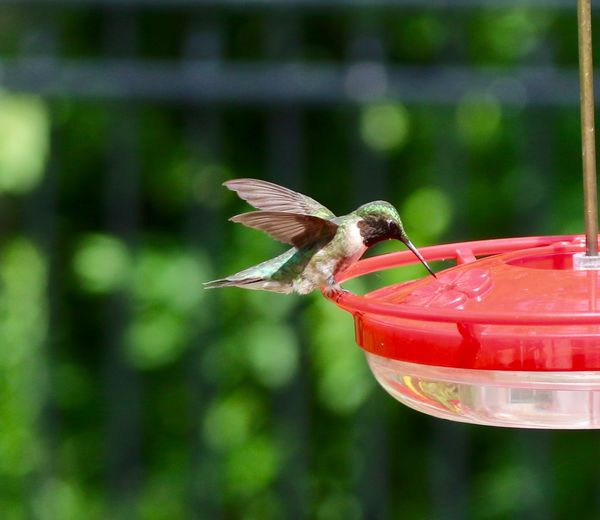Depth of field question
Jul 11, 2016 08:22:30 #
Robert R wrote:
Thanks, I will try that next time. I was trying to use lower ISO to reduce noise, but will try higher.
You shouldn't have any problem with noise from higher ISO until you get north of 1000 and even at that speed you probably won't notice it against your relatively dark back ground. To find out how high you can get try several trial shots at ever increasing ISO's, when you see noise, go back until it vanishes; that will be your limit.
Jul 11, 2016 08:23:30 #
Szalajj wrote:
I'm going to go at my answer a little differently.... (show quote)
Thanks for suggestion. I use Canon 7D mark 2. I am not sure what menu item to check for sharp focus. My picture style is set on standard, if that is what you are referring to.
Jul 11, 2016 08:42:28 #
Robert R wrote:
I have been experimenting with hummingbird photos.... (show quote)
Probably a lot of things will work but not what you did. The more automation, the worse I find. I don't like Auto ISO at all, I've ruined a entire days work with that BS. Full auto is even more useless. The photographer needs to make some choices or the exposure ends up being mindless. Just try Tv mode; any of 1/1000 s, 1/1500 s, 1/2000 s; ISO 800. Or Av mode; with any of f/8, f/11, f/16; ISO 800. Perhaps once you get a few images you like that are the correct exposure, set everything but Focus (AF), to Manual.
Jul 11, 2016 09:13:37 #
Robert R wrote:
I have been experimenting with hummingbird photos.... (show quote)
Deeper DoF will cause the background to come more into focus and make it even more distracting than it is now. Use a longer focal length. 200mm at F8 and 10ft distance should give you more of what you want and less of what you don't want in your image.
Use a pair of radio triggered speedlights - full power, up close to the feeder - A Canon 600 EX-II-RT will provide a 1/2000 sec pop, while giving you enough light to be able to use a smaller aperture and lower ISO. Also there is the added benefit that if you shoot at the right time of day, you can diminish the amount of ambient light, relying more on the speedlight(s) to illuminate the subject.
The image was taken in 2011, using old stuff. The lens was used at a distance of about 10 ft, near it's minimum focusing distance, which is why the background is not at all distracting. Depth of field is amazingly paper thin at about 1/2" at this distance.
ISO 800 is not particularly clean on this camera, but by exposing to the right (and not so much that stuff is blown out, and careful post processing, you can get a lot of useful information out of that 12 mp cropped sensor camera.
Jul 11, 2016 09:20:43 #
lamiaceae wrote:
Probably a lot of things will work but not what yo... (show quote)
Thank you, I appreciate your suggestion. I was using auto ISO because there were big cumulus clouds around and the light was going from full sun to shade. I was having to change from ISO 400 to 800. Trying to limit movement around the feeder, I put it on auto because I knew it would be below ISO 1000. I did get one acceptable image with my settings, ISO 400, f4, 1/2000, the bird was in the narrow depth of field.
Jul 11, 2016 09:23:59 #
Gene51 wrote:
Deeper DoF will cause the background to come more ... (show quote)
Thank you for suggestion. That is really a great photo. Here is one that is similar to yours. ISO 400, f4, 1/2000, tripod with cable release.
Jul 11, 2016 11:36:53 #
Robert R wrote:
Thank you for suggestion. That is really a great photo. Here is one that is similar to yours. ISO 400, f4, 1/2000, tripod with cable release.
Thanks!
Looks like same bird, different feeder

A little post processing to lighten the shadow on the bird, maybe adding some blur to the background.
I had my camera on a tripod, but I never use a cable release - I find it cumbersome. I get better results just pushing the button, carefully.
You can see the difference you can get by using a longer focal length, both in the detail on the bird, and in the smoothness of the background.
Jul 11, 2016 12:30:25 #
Gene51 wrote:
Thanks! br br Looks like same bird, different fee... (show quote)
Thanks for the suggestions. Looking back on my photos from several years ago I cannot believe how I have improved, mostly by following the suggestions on this website. I still have a long way to go, but I like the progress I have made. Thanks to all.
Jul 11, 2016 19:22:50 #
Szalajj
Loc: Salem, NH
Robert R wrote:
Thanks for suggestion. I use Canon 7D mark 2. I am not sure what menu item to check for sharp focus. My picture style is set on standard, if that is what you are referring to.
Yes, I had to download a manual for your camera to check it.
I was supposed to order that same camera for myself last Friday, but I was notified earlier in the week that my temp contract is ending in 5 weeks, so my camera purchase has been put on hold until I find a new job.
Jul 12, 2016 07:17:35 #
At 70mm, f/4 and 10' away...you have a total DOF or 1'-4" (8" in front and 9" in rear) if you focused in the hanger.
Jul 12, 2016 08:29:08 #
Your problem is common and should be easily corrected. At f4 you have little DOF and in addition the 70-200 compresses the shot a fair amount. Just boost up your aperture to about f8 and adjust your speed accordingly. Not sure what ISO your using but that could possibly be raised. Their are three parts to getting a proper exposure. The need to balance for each other to accomplish the correct exposure. Each helps the other. Don't be afraid to raise the the aperture even though you may need a faster shutter speed for the tiny birds. I am sure you are on a tripod and you mentioned a cable release so play with the s/s and the iso. You will get it but rarely on the first try. You may want to try a little shorter lens also such as a 24-105mm. They have f4 and f2.8 but since you are so close and they are feeding close to you that may be a quick answer.
Jul 12, 2016 09:38:47 #
The 1/3 in front and 2/3 behind is a generally accepted rule of thumb and is a rough estimate not 100% accurate in all cases
Jul 12, 2016 09:41:43 #
Robert R wrote:
I have been experimenting with hummingbird photos.... (show quote)
+++++++++++++++++++++++++++++++
Use strobes set on their highest power settings.. This will enable you to focus upon a larger area of depth and a the lens set upon a higher f/stop which means a smaller opening..
Jul 12, 2016 09:49:39 #
EmilMiller wrote:
Depth of field is 1/3 in front and 2/3 behind the focal point, take that into consideration.
The old trade off. Where does your priority lie, a good quality out of focus shot or a lesser quality well focused shot?
Jul 12, 2016 10:19:58 #
If you want to reply, then register here. Registration is free and your account is created instantly, so you can post right away.











